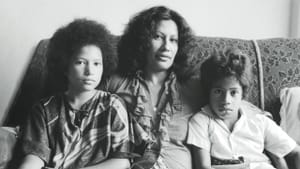Stay in the Loop
BSR publishes on a weekly schedule, with an email newsletter every Wednesday and Thursday morning. There’s no paywall, and subscribing is always free.
Honoring Indigenous Peoples’ Day in Philly
The Weekly Roundup, October 6-12

This year, Philadelphia made it official: instead of observing that guy, the city designated the second Monday of October to be Indigenous Peoples’ Day. For this week’s roundup, I’m focusing on picks that center Indigenous people. A pair of celebrations happening in the city highlight the roundup, and a few selections that you can experience from anywhere, anytime to go beyond just one day.
Indigenous Peoples' Day in Philadelphia
Indigenous Peoples' Day at Bartram’s Garden
Sunday, October 10, 12-4pm
Bartram’s Garden, 5400 Lindbergh Boulevard, Philadelphia
Hosted by Ollin Yoliztli Calmecac (OYC) and Native Nations Dance Theater (NNDT), this outdoor family-friendly event promises dancers, drummers, speakers, vendors, children’s activities, and more. The gathering is free and open to the public.
OYC is an educational organization raising awareness about the history and culture of Indigenous peoples, particularly the Mexicayotl traditions and teachings. They also are a dance and cultural troupe and are based in South Philly. NNDT is Philly’s only Indigenous professional touring dance company.
Indigenous Peoples' Day at Shackamaxon
Monday, October 11, 11am-5pm
Penn Treaty Park, 1301 North Beach Street, Philadelphia
Indigenous Peoples' Day Philly hosts an afternoon featuring Indigenous dignitaries, artists, vendors, and Lenape guests. Guests include Tchin Storytelling, We are the Seeds, Isaac Murdoch, Inkarayku, Marcus “Quese IMC” Frejo, and more. A suggested donation of $10 for adults and $5 for seniors and children is requested.
Books to read
Braiding Sweetgrass
By Robin Wall Kimmerer
Drawing on her life as an Indigenous scientist, a mother, and a woman, Kimmerer shows how "other living beings—asters and goldenrod, strawberries and squash, salamanders, algae, and sweetgrass—offer us gifts and lessons, even if we’ve forgotten how to hear their voices."
One of the blessings of this cursed pandemic is that I’ve had the chance to not only slow down and smell the flowers but to honor them and respect them for the vitality they bring us every day. As a city boy who’s been trying to connect more with nature and the earth in a physical and spiritual sense, this book feels right up my alley.
How We Became Human
By Joy Harjo
It might be nearly 20 years old at this point, but Joy Harjo’s collection of poems from 1975-2001 are still relevant. The collection explores its title question as Harjo, the 23rd US Poet Laureate and member of the Mvskoke Nation, penned it over her 28-year career.
Heart Berries: A Memoir
By Terese Marie Mailhot
While hospitalized and facing a dual diagnosis of post-traumatic stress disorder and bipolar II disorder, Mailhot got to writing what would become Heart Berries, a memoir of her dysfunctional upbringing: her mother was a social worker and activist who “had a thing for prisoners,” and her father was a brilliant artist and an abusive alcoholic who was murdered under mysterious circumstances. The book also explores “how difficult it is to love someone while dragging the long shadows of shame.”
Hope Matters
By Lee Maracle, Columpa Bobb, and Tania Carter
Maracle and her daughters focus on the journey of Indigenous people from colonial beginnings to reconciliation, and the journey of Maracle and her relationship with her daughters. Born from the poetry they’d all write together when Bobb and Carter were children, they knew one day they’d write a book together.
Podcasts to listen to
This podcast considers relationships between Indigenous Peoples and Black peoples on Turtle Island. While its most recent episode is dated last spring, there are plenty of evergreen topics to dive into.
Molly Swain and Chelsea Vowel are two Métis women who break down tropes, themes, and the hidden meanings in science fiction, “the whitest genre of film and television we've ever known.” I think many of us could use a little decolonization when it comes to our relationship with sci-fi, so check this one out!
Matika Wilbur (Swinomish and Tulalip), and Desi Small-Rodriguez (Northern Cheyenne) explore all different kinds of relationships—to land, to our creatural relatives, and to one another.
Documentaries to watch
Brianna Jonnie is an Indigenous teenager (at the time of filming) in Winnipeg fighting for missing and murdered Indigenous women and girls. The film opens on the bank of the notorious Red River, where Tina Fontaine was found in the summer of 2014. Jonnie’s fight started when she sent a letter to the chief of the Winnipeg police force when she was 14, and she has been fighting since.
Merata: How Mum Decolonized the Screen
This documentary follows the story of Merata Mita and how her filmmaking intersected with the lives of her children and Indigenous filmmakers all over the world. Mita was the first Māori woman to write and direct a feature film and had emerged as one of New Zealand’s best-known filmmakers. The film was made by Mita’s youngest son, drawing footage from her work, interviews with her before she picked up a camera, and reflections from his siblings and other folks she influenced.
It’s not news that Hollywood has a representation problem, but Neil Diamond’s 2009 documentary chronicles the film industry’s long history of portraying various, harmful stereotypes about Indigenous peoples. It’s available on Amazon (free for Prime users), but it’s also streaming on Sundance Now.
Sign up for our newsletter
All of the week's new articles, all in one place. Sign up for the free weekly BSR newsletters, and don't miss a conversation.
 Kyle V. Hiller
Kyle V. Hiller